From Western FarmPress
The UC is suggesting practices that could help control spread of the wild rice type.
Written by Todd Fitchette | Apr 20, 2021
California rice growers with troublesome patches of weedy rice, or red rice, may want to take advantage of the drought and low water allocations to fallow those fields with known populations of the plant.
This could be advantageous to growers as the University of California is suggesting some “dry fallow" practices that could help control spread of the wild rice type.
UC has identified seven types of weedy rice across about 14,000 acres of farmland in the Sacramento Valley since it was rediscovered in 2010 in one Sacramento Valley county. Because there are no herbicides to control weedy rice, rouging or managed fallowing are the only options for control.
Managed fallowing can help with some varieties of weedy rice, according to Whitney Brim-DeForest, Extension rice advisor with the University of California. This is a practice that still uses irrigation water but does so on a more limited basis than if fields were planted to common rice varieties. During the last multi-year drought period a few years ago she said some growers left fields unplanted for more than one season to get a handle on weedy rice populations. That seemed to work for them.
In the water-short year growers face this year, dry fallowing may help, according to UC and the California Rice Commission. It is theorized that predation of seeds by birds or desiccation (drying out) of the seed is possible. Even so, weedy rice is known to survive a long time in the soil. Eradication therefore becomes difficult if those seeds germinate and can go to seed themselves, which is why weed, and rice specialists encourage not allowing weeds from fallowed fields to go to seed.
Not all growers have the luxury of a managed fallowing plan, which includes the use of limited amounts of irrigation water.
In the case of dry fallowed management, a post-emergence herbicide may be helpful.
UC Extension advisors are recommending growers in such cases simply leave the fields alone. Do not till the fallow fields as that could spread weedy rice seed.
"Just leave it alone unless you see some weedy rice come up, then till it," Brim-DeForest said. "We don't want anything going to seed."
She encourages growers to watch for signs of weedy rice in those fields that may see rain from spring or summer thunderstorms.
Managed fallowing
Under a managed fallowing plan, growers who can run irrigation water should do the following, according to UC Extension:
- Do not till before flooding in the spring.
- Flood, block the drain and allow water to subside into the soil.
- Wait for weeds to emerge – typically no more than a month for most weedy rice species, then apply glyphosate.
- About two weeks after the glyphosate treatment, or when soil is dry enough for equipment, disc the soil.
- After discing, reflood, block the drain, and allow water to subside.
- Repeat glyphosate application about two weeks after seedling emergence.
For growers who cannot or do not want to leave fields out of production, the University of California has some best management practices to reduce the likelihood of spreading weedy rice.
Using only certified seed and not using infested fields for seed are perhaps the best way to ensure it does not spread to new fields. Careful management of harvest and other equipment is another method. Growers with known populations of weedy rice may want to clean that equipment immediately after using it in known fields or harvest those fields last, when equipment will be stored and can be cleaned at more convenient time, Brim-DeForest said.
With weedy rice infestations in Southern states reducing cultivated rice yields by as much as 60%, California growers are encouraged to stay on top of best management practices that includes use of certified seed – a law in California. In the case of specialty varieties that cannot be verified and merchandised as certified seed, growers should use seed that has been approved through the Rice Seed Quality Assurance Program.
Attached Images:

